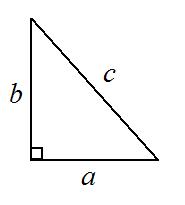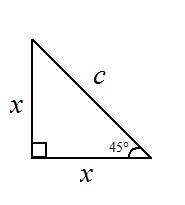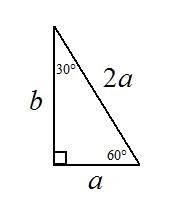mNo edit summary |
|||
| Line 6: | Line 6: | ||
<blockquote>In any right triangle, the area of the square whose side is the hypotenuse is equal to the sum of the areas of the squares whose sides are the two legs.</blockquote> |
<blockquote>In any right triangle, the area of the square whose side is the hypotenuse is equal to the sum of the areas of the squares whose sides are the two legs.</blockquote> |
||
| − | In other words, |
+ | In other words, |
| − | :<math>a^2 + b^2 = c^2</math>. |
+ | :<math>a^2 + b^2 = c^2</math>. |
This is read as, "''a'' squared plus ''b'' squared equals ''c'' squared." |
This is read as, "''a'' squared plus ''b'' squared equals ''c'' squared." |
||
| Line 88: | Line 88: | ||
==='''Obtuse Triangles'''=== |
==='''Obtuse Triangles'''=== |
||
If a triangle is obtuse, then <math>a^2 + b^2 > c^2</math>. |
If a triangle is obtuse, then <math>a^2 + b^2 > c^2</math>. |
||
| + | |||
| + | ==See Also== |
||
| + | * [[Rationalizing Denominators]] |
||
Revision as of 02:12, 9 May 2012

A right triangle with the sides labeled a, b, and c.
The Pythagorean Theorem is a mathematical formula used for finding missing lengths of right triangles. It is named after the Greek mathematician Pythagoras, who by tradition is often credited with its discovery and proof, though many speculate that knowledge of the Pythagorean Theorem predates him.
According to the Pythagorean Theorem,
In any right triangle, the area of the square whose side is the hypotenuse is equal to the sum of the areas of the squares whose sides are the two legs.
In other words,
- .
This is read as, "a squared plus b squared equals c squared."
How It Works
Let's say you were to find the length of side a, where the length of b is 4 and the length of c is 5.
Since the square root of 9 is 3, then .
Converse
If , then the angle between a and b is 90°.
Shortcuts
There are special types of right triangles in which the Pythagorean Theorem can be used to find missing lengths easily.
45-45-90 Triangles
Full article: Triangles

A 45-45-90 triangle with sides labeled.
A 45-45-90 triangle is a right triangle with the angles measuring at 45° and 90° only.
Here is the formula for finding the missing lengths of 45-45-90 triangles.
Since , and or , then the formula becomes
- , or
- .
The shortcut for finding the length of c:
- .
For example, say that the value of x is 7. That would mean that the value of c is .
To find x,
- , or
- .
Did You Know? You can find two 45-45-90 triangles when you bisect a square.
30-60-90 Triangles
Full article: Triangles

A 30-60-90 triangle with sides labeled. Note the absence of c.
A 30-60-90 triangle is a right triangle with the angles measuring at 30°, 60°, and 90°. Two of these can be found by bisecting an equilateral triangle.
Since the sides of an equilateral triangle are the same length, then
- .
Therefore, the formula becomes
- , or
- .
To find the length of b,
- .
To find a,
- , or
- .
Use to Identify Other Triangles
Acute Triangles
If a triangle is acute, then .
Obtuse Triangles
If a triangle is obtuse, then .





















